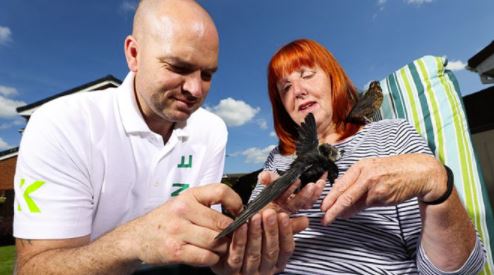
Kill Line Pest Control is helping save our feathered friends by donating wasp larvae to a bird rescuer

Sean Mooney, of Teesside-based Kill Line, has had a busy summer, ethically removing bee and wasp nests from places where they’re causing problems.
Former blacksmith Sean’s firm minimises the use of poisons and rodenticides, preferring to remove nests responsibly and with as little impact on the environment as possible.
But when he heard of a plea from Ingleby Barwick resident Sue Francis, who rehabilitates birds in distress, he thought of another way he could help out.
Sue was asking for “drone brood” – male bee or wasp larvae that are a nutritious meal for birds. The brood are found in a honeycomb-like structure in bee and wasp nests – and Sean sees plenty of it.
So rather than throwing it out, Sean contacted Sue and now he’s supplying her with drone brood that would otherwise just go to waste.
And as our pictures show, the birds – starlings, swifts, crows and the like – are thriving!
Sean explained:
“I thought, ‘I’m pulling these wasp nests out with a load of wasp grubs in them, and they’re just getting destroyed’ so I asked Sue if they’d be any good for her.
“The larvae are ideal because they’re soft and high in nutrition. I remove the wasps so she just gets the comb with the larvae in them and she feeds all the birds, who are fledging as a result.”
Because he doesn’t use chemicals, the brood isn’t contaminated, making it an ideal food for the birds.
Sean said:
“With a wasp nest, if we can get to it in general, we will take it out without using any poison.
We’ll just physically remove it. We’re quite conscious that if we don’t have to use any chemicals, why would you if there’s another way round it?”
The amount of brood available depends on the nest size, which get pretty hefty at this time of year.
Sean said:
“The nests we got earlier in the year were a lot smaller than now. A typical wasp nest at this time of year is about the size of a basketball, but they’ll be beachball size by the end of the year.
“The brood ‘cake’, as we call it, is like honeycomb – but instead of honey, there’s a big white maggot in the middle of it which Sue just picks out and feeds to the bird. Sometimes I drop them off that fresh, they’re still alive. We gave a crow a lump of cake and it just flipped it over and spent ages pulling the larvae out, eating them.
“I don’t charge Sue – it would just go in the bin or be burnt and destroyed otherwise.”
Sean says it’s been a busy summer for Kill Line – so busy, in fact, he’s taken on another member of staff, Ellis Hoey, who’s just finished his Level 2 in RSPH (Royal Society of Public Health) pest control.
Bee and wasp nest removals from everything from local councils and colleges to private homes have made up most of the workload – “we’re the only firm that deals with honey bee removals in the
North-east properly, so we’ve got a bit of a niche at the moment,” says Sean – while he’s even been brought in to do a mink trapping job for a commercial fishery.
And with autumn approaching, he’s ready to deal with the annual invasion of rats, mice and moles.
He said:
“It’s getting to that time of year when rats are going to become a problem and 90 per cent of rat issues are going to be connected to your drains.
“Everyone thinks rats come because your house is dirty but in general it’s not true. So be mindful that if you have a rat problem, make sure the source of the problem is fixed.”
By Kill Line Pest Control
593 Views
Recent Posts
- Heliex Power Saves Formaldehyde Producers £500k
- NEPIC spoke with member, Alpek Polyester UK Ltd to learn how they develop their workforce for the future and discover more about their mission to educate on PET
- FEG Global Designs Self-Powering Facility In Ghana
- Thorne & Derrick Electrifying Industry With 3M
- UK MP and chemical engineer Chris McDonald keen to unite the worlds of engineering and politics
Back to News >



